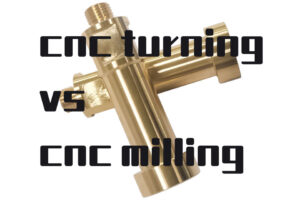CNC Turning vs CNC Milling: Which One Is Right for You?
 In the world of manufacturing, there are two primary methods of machining: CNC turning and CNC milling. Both of these methods are highly effective and widely used in the industry, but they each have their own unique strengths and weaknesses. So, which one is right for you? Let’s take a closer look.
In the world of manufacturing, there are two primary methods of machining: CNC turning and CNC milling. Both of these methods are highly effective and widely used in the industry, but they each have their own unique strengths and weaknesses. So, which one is right for you? Let’s take a closer look.
CNC Turning
CNC turning is a machining process in which a cutting tool is used to remove material from a rotating workpiece. This process is typically used to create cylindrical parts, such as shafts, bolts, and nuts. The machine used for CNC turning is called a lathe, and it can be either manual or automated.
One of the biggest advantages of CNC turning is its ability to create highly accurate cylindrical parts with a smooth finish. This makes it an ideal choice for creating parts that require tight tolerances, such as bearings and gears. Another advantage of CNC turning is its ability to work with a wide range of materials, including metals, plastics, and even wood.
However, there are also some limitations to CNC turning. For example, it may not be the best choice for creating complex parts with multiple features, as it is primarily designed for creating cylindrical shapes. Additionally, CNC turning may not be the most efficient process for creating large volumes of parts, as it can be time-consuming and may require frequent tool changes.
CNC Milling
CNC milling is a machining process in which a cutting tool is used to remove material from a stationary workpiece. This process is typically used to create parts with complex shapes and features, such as gears, molds, and brackets. The machine used for CNC milling is called a mill, and it can be either manual or automated.
One of the biggest advantages of CNC milling is its ability to create highly complex parts with a high degree of accuracy. This makes it an ideal choice for creating parts with intricate shapes and features, such as medical implants and aerospace components. Additionally, CNC milling can be a highly efficient process for creating large volumes of parts, as it can be automated and require minimal operator intervention.
However, there are also some limitations to CNC milling. For example, it may not be the best choice for creating parts with a smooth surface finish, as the process can leave tool marks on the surface of the part. Additionally, CNC milling may not be the most cost-effective process for creating simple cylindrical parts, as it is primarily designed for creating complex shapes.
Conclusion
In conclusion, both CNC turning and CNC milling are highly effective machining processes with their own unique strengths and weaknesses. The choice between the two ultimately depends on the specific needs of your project, such as the complexity of the part, the required accuracy, and the desired surface finish. By understanding the differences between these two processes, you can make an informed decision about which one is right for your project.






